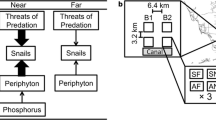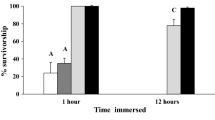Summary
The competitive interactions between roach (Rutilus rutilus) and rudd (Scardinius erythrophthalmus) were investigated in two habitats, the open water and the waterlily zone. The growth rates of both species in enclosures were lower when confined together than when alone, demonstrating interspecific competition. Allopatric roach had the highest growth rate in both habitats although the open water was preferred. The diets of both species were dominated by zooplankton in both the open water and waterlily zones. In laboratory experiments, roach had significantly higher feeding rates than rudd when fed D. magna and Cyclops sp. The impact of roach on the mean sizes and densities of zooplankton in the enclosures, together with the results from the laboratory study, indicate that roach were competitively superior in the open water. Because of high mortality in the sympatric waterlily enclosure, no conclusions about interspecific competition in this habitat could be drawn. The observed habitat segregation between roach and rudd was at least partly interactive.
Similar content being viewed by others
References
Andruzak H, Northcote TG (1971) Segregation between adult cutthroat trout (Salmo clarki) and dolly varden (Salvelinus malma) in small coastal British Columbia lakes. J Fish Res Board Can 28:1259–1268
Brian MV (1956) Segregation of species of the ant genus Myrmica. J Anim Ecol 25:319–337
Burrough RJ, Bregazzi PR, Kennedy CR (1979) Interspecific dominance amongst three species of coarse fish in Slapton Ley, Devon. J Fish Biol 15:535–544
Case TJ (1979) Optimal size and an animal's diet. Acta Biotheor 28:54–69
Confer JL, Howick GL, Corette MH, Kramer SL, Fitzgibbon S, Landesberg R (1978) Visual predation by planktivores. Oikos 31:27–37
Connell JH (1980) Diversity and the coevolution of competitors, or the ghost of competition past. Oikos 35:131–138
Connell JH (1983) On the prevalence and relative importance of interspecific competition: Evidence from field experiments. Am Nat 122:661–696
Finger TR (1982) Interactive segregation among three species of sculpins (Cottus). Copeia 1982:680–694
Gardner MB (1981) Mechanisms of size selectivity by planktivorous fish: a test of hypotheses. Ecology 62:571–578
Hassel MP (1978) The dynamics of arthropod predator-prey systems. Princeton University Press, Princeton, New Jersey
Holcik J (1967) Life history of the rudd-Scardinius erythrophthalmus (Linnaeus, 1758) in the Klicava reservoir. Vestn Cesk Spol Zool 31:335–348
Hurlbert SH (1984) Pseudoreplication and the design of ecological experiments. Ecol Monogr 54:187–211
Kennedy M, Fitzmaurice P (1974) Biology of the rudd Scardinius erythrophthalmus (L.) in Irish waters. Proc R Ir Acad Vol 74 sect B:245–305
Nilsson NA (1960) Seasonal fluctuations in the food segregation of trout, char and whitefish in 14 North-Swedish lakes. Rep Inst Fresh Res, Drottningholm no 41:185–205
Nilsson NA (1965) Food segregation between salmonid species in North Sweden. Rep Inst Freshw Res, Drottningholm no 46:58–78
Nilsson NA, Northcote TG (1981) Rainbow trout (Salmo gairdneri) and cutthroat trout (S. clarki) interactions in coastal British Columbia lakes. Can J Fish Aquat Sci 38:1228–1246
Peirson G, Cryer M, Winfield IJ, Townsend CR (1985) The impact of reduced nutrient loading on the fish community of a small isolated lake, Alderfen broad. Proceedings from the 4th British Freshwater Fish Conference, Liverpool University 1985
Persson L (1983a) Food consumption and competition between ageclasses in a perch Perca fluviatilis population in a shallow eutrophic lake. Oikos 40:197–207
Persson L (1983b) Food consumption and the significance of detritus and algae to intraspecific competition in roach Rutilus rutilus in a shallow eutrophic lake. Oikos 41:118–125
Persson L (1983c) Effects of intra- and interspecific competition on dynamics and size structure of a perch Perca fluviatilis and a roach Rutilus rutilus population. Oikos 41:126–132
Persson L (1985) Asymmetrical competition: are larger animals competitively superior? Am Nat 126:261–266
Persson L (1986) Temperature-induced shift in foraging ability in two fish species; roach (Rutilus rutilus) and perch (Perca fluviatilis)-implications for coexistence between poikilotherms. J Anim Ecol 55:829–839
Roughgarden J (1974) Niche width: Biogeographic patterns among Anolis lizard populations. Am Nat 108:429–442
Roughgarden J (1979) Theory of population genetics and evolutionary ecology; an introduction. MacMillan, New York
Schoener TW (1969) Models of optimal size for solitary predators. Am Nat 103:277–313
Schoener TW (1974) Resource partitioning in ecological communities. Science 185:27–39
Schoener TW (1982) The controversy over interspecific competition. Am Sci 70:586–585
Ware DM (1972) Predation by rainbow trout (Salmo gairdneri): The influence of hunger, prey density, and prey size. J Fish Res Board Canada 29:1193–1201
Werner EE (1974) The fish size, prey size, handling time relation in several sunfishes and some implications. J Fish Res Board of Canada 31:1531–1536
Werner EE (1977) Species packing and niche complementarity in three sunfishes. Am Nat 111:553–578
Werner EE (1986) Species interactions in freshwater fish communities. In: Diamond J, Case T (eds) Community Ecology, Harper and Row, New York
Werner EE, Hall DJ (1976) Niche shifts in sunfishes: Experimental evidence and significance. Science 191:404–406
Werner EE, Hall DJ (1977a) Response to VC Maiorana. Science 195:94–95
Werner EE, Hall DJ (1977b) Competition and habitat shift in two sunfishes (Centrarchidae). Ecology 58:869–876
Werner EE, Hall DJ (1979) Foraging efficiency and habitat switching in competing sunfishes. Ecology 60:256–264
Vinyard GL, O'Brien WJ (1976) Effects of light and turbidity on the reaction distance of bluegill (Lepomis macrochirus). J Fish Res Board Canada 33:2845–2849
Winberg GG (1961) New informations on metabolic rate in fishes. J Fish Res Board Canada Translation series No 362
Author information
Authors and Affiliations
Rights and permissions
About this article
Cite this article
Johansson, L. Experimental evidence for interactive habitat segregation between roach (Rutilus rutilus) and rudd (Scardinius erythrophthalmus) in a shallow eutrophic lake. Oecologia 73, 21–27 (1987). https://doi.org/10.1007/BF00376972
Received:
Issue Date:
DOI: https://doi.org/10.1007/BF00376972




